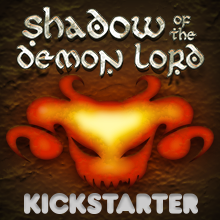1. The Gods are Distant Powers
Whether the gods exist or not remains an open question. While societies all over the world have their religions, worshipping gods, monsters, the spirits of the ancestors, or something else, the gods rarely, if ever, take a direct hand in mortal affairs. Instead, it falls to their devoted servants to advance their aims in the world and reinforce the faith that sustains the gods’ immortal existence.
In the lands of Rûl, people tend follow the Old Faith, a pantheistic religion that traces its origins back to the dawn of mankind, or have embraced the Cult of the New God, a monotheistic religion with many sects, each with their own interpretations of their divine patron. On the fringes, one finds the ancestor worship of the dwarfs, the dour gods of blood and iron feared by the jotun, and the dreaming Earth Lord sleeping in the center of the world.
2. Hidden Worlds
Other worlds exist within the mortal world’s bounds, entire realities that drift across its surface like soap bubbles on water. Such worlds include the Hidden Kingdoms, the realms of the faerie, the Underworld, Hell, Elysium, and countless others places strange and terrifying. Most mortals never encounter these places during their lifetimes. However, accident, weird magic, or the influence of the Demon Lord may land the living in the realms of the dead or afford a glimpse at the dreamy vistas of Alfheim.
3. Magic is Real
The world is a magical place. Magic infuses all things and is all that remains of the creative force that spun the universe out from primordial chaos. Magic’s abundance means anyone with the will, time, and talent can learn to harness its power. Some people have the gift for wielding magic and call upon the power from within. Others spend long years in study, uncovering the secrets of cosmic power from ancient tomes and scrolls written by ancient masters who recorded their discoveries for those that came after. And then there are the priests, souls devoted to the distant gods and who champion their causes in the world.
Aside from spells, magic sometimes lingers in objects infused with its power or created by it. Magical energy also gathers in certain places, making spells easier to cast or producing unexpected effects.
Magic’s abundance does little to soften views toward its use. In all but the most cosmopolitan places, humans largely distrust magic-users. After all, a skilled practitioner can throw lightning or fire, bestow horrific curses, or conjure foul monsters from the Void. Priests usually find a bit more acceptance than others, but only in communities where their beliefs are welcome. Witches, on the other hand, tend to be respected and valued in rural communities, but persecuted in civilized areas where the cult of the New God is strongest. Others may face suspicion, ostracism, or violence depending on the power they wield and the strength of a community’s superstitions.
4. Mortals Live Many Lives
Death is not the end for mortals. Death marks the transition from one life to the next. Upon dying, the soul pulls free from the flesh and remains for a short time before descending into the Underworld. In this gloomy place, the memories of the life left fade until nothing remains of the person who once was. Only then will the soul drift from the Underworld and enter a new body born into the world.
Not all souls go to the Underworld, however. Corruption weighs down the soul, stained by foul acts performed in life that can only be cleansed by torment. Mortals leading depraved and monstrous lives find Hell awaits them in the afterlife. There, twisted faeries and other, darker supernatural beings scourged the corruption from souls, feasting on those dark acts and savoring the memories of those acts as recalled when consumed. The darker the stains, the longer the soul remains in Hell, with some never truly escaping the damnation they earned.
5. Science and Technology
Humanity has made great strides in science and technology, discovering black powder, clockwork, and steam technologies. While still expensive and exotic, pistols and rifles are becoming more widespread. Clockwork automatons work alongside laborers in construction and manufacturing. Engineers have begun to take the steps in creating steam engines. In the great Nine Cities of the east, flying ships—balloons and zeppelins—have begun to appear. Had the Empire not collapsed, the advances may have taken mankind into a new era of progress and even greater discovery.
6. The World is filled with Terrible Monsters
Despite mankind’s efforts to tame the land and secure its borders, the world remains a dangerous place. Wild animals, many of which possess strange and unnatural powers, stalk the wild places. Drakes wing through the skies, descending to snatch livestock or people, blasting villages with fire spewed from their mouths. Trolls and giants roam the hinterlands, while undead claw their way free from shallow graves to terrorize the living. No matter the efforts civilization makes to drive back these threats, they return again and again, each time with greater numbers.
7. The Empire Burns
The greatest and mightiest civilization to appear in these lands now teeters on the brink of collapse. The Emperor lies dead, strangled by the Orc King who claimed the Alabaster Throne for himself and the legions of freed slaves that look to him for leadership. The uprising in the capital has sent shockwaves through the rest of the Empire. Orcs have risen against their masters as word spreads and mobs of vengeful orcs rampage across the countryside, burning, looting, and killing wherever they go.
The Empire’s instability has proven an invitation for other savage humanoids to exploit the weakness. Beastmen spill out from the old forests and broken lands, while trolls and giants resume their age-old wars against the faeries. Worst of all, cultists devoted to the Demon Lord have grown bolder and even now work to loose demons from the Void and hasten the arrival of their unspeakable master.
Refugees flee to the cities, hunkering down behind the walls and living in squalid, overcrowded conditions in the hopes that somehow they will escape the doom that casts its shadow across the lands. Order crumbles in the face of the chaos and upheaval. City leaders hide in their homes, nobles seal off their castles, deaf to the cries of the people beyond their doors. These are dark times, and many believe they signal the first days of mankind’s last age.
8. The Shadow of the Demon Lord
The Demon Lord is a menacing, shadowy figure lurking in the Void between worlds. It craves escape from this realm for one purpose only: to destroy the universe and devour the souls living in it. Countering the Demon Lord’s efforts are the angels, guardians of the ordered universe who drift among the stars to shore up the weakening boundaries between this reality and the yawning darkness beyond.
Despite their efforts, the fabric of reality has grown weaker with reckless magic and the actions of the mad and deranged who seek the final oblivion the Demon Lord promises. Cults of his servants have spread throughout the empire and perform horrid rituals to call forth lesser demons and tear holes in reality for the coming of their master. Given the troubles plaguing the Empire, it seems to many the Demon Lord is close to emerging, and when it does, all will be lost.
As the Demon Lord’s influence grows, it assails the world with catastrophes. Plagues, war, supernatural events such as the rising numbers of uncontrolled undead, the awakening of ancient monsters, corrupted magic and more trouble the world. The closer the Demon Lord gets, the worse the situation becomes until the Devourer of Worlds finally emerges to snuff out the stars, still the movements of the celestial bodies, and put an end to all life and all things.

